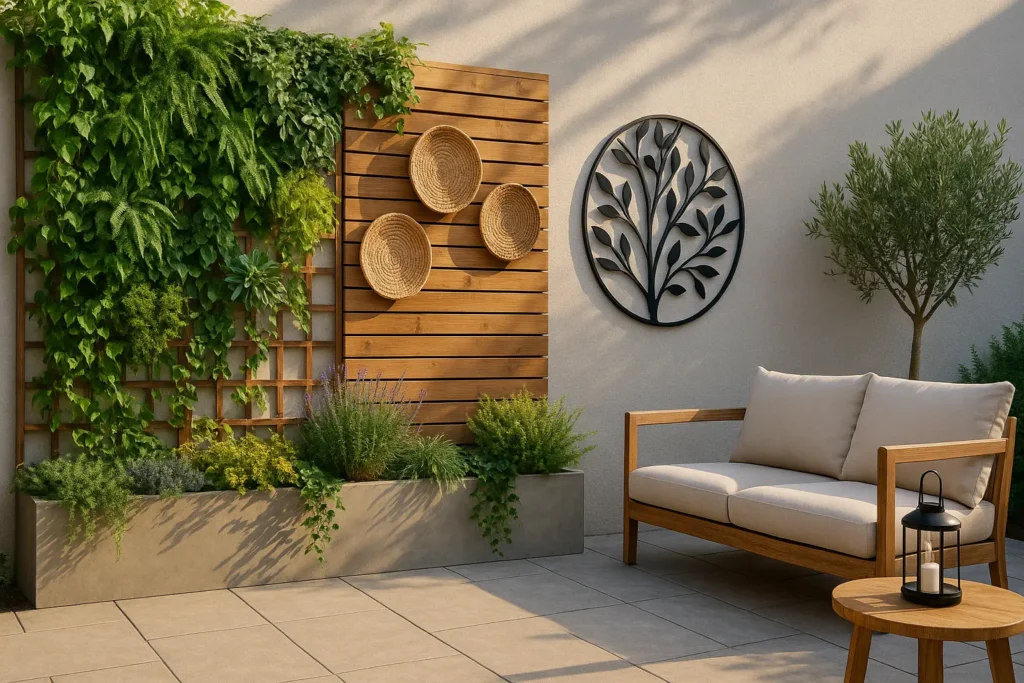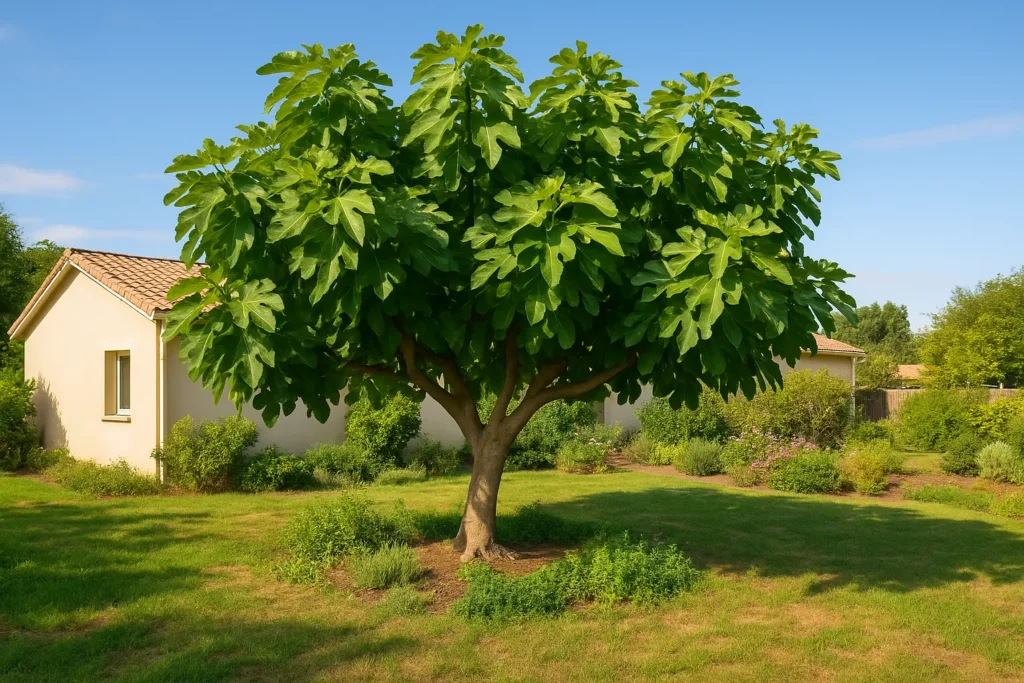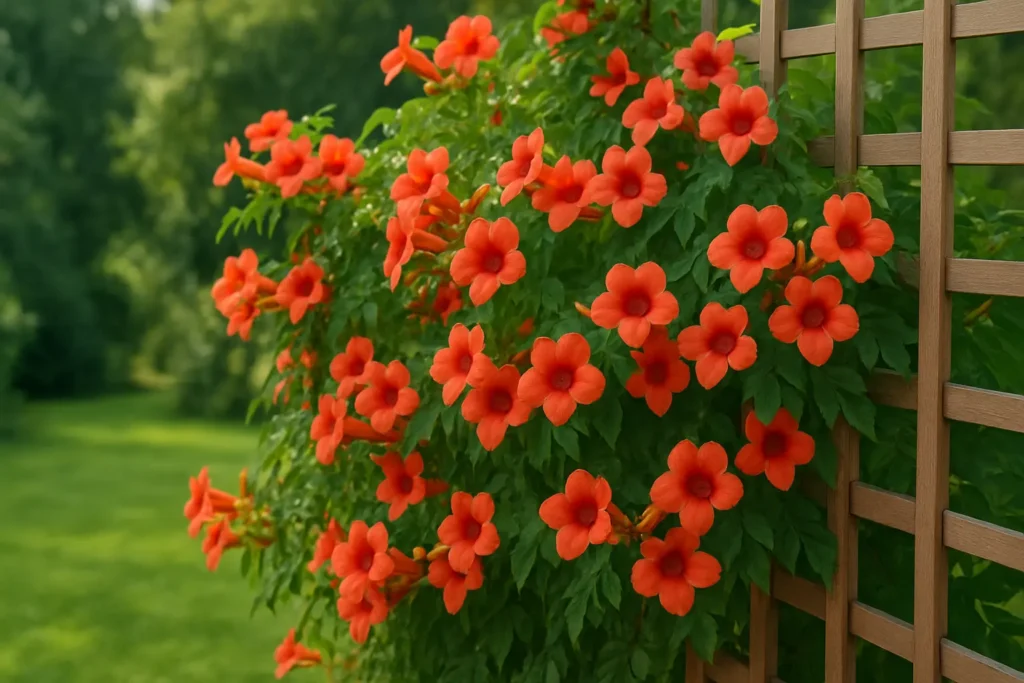What could be more delightful than a moment suspended in a hammock? Whether it's for a moment of reading, a restorative nap, or simply to contemplate the sky, install a hammock at home transforms any space into a haven of peace. At La Maison Coloniale, we believe this bohemian piece of furniture will bring a touch of escape to your home or garden. Setting up a hammock isn't complicated, but it does require some technical knowledge to ensure comfort and safety. We'll guide you step by step through this project, which invites you to travel, without even leaving your comfort zone.
Our article in brief:
Setting up a hammock transforms any space into a haven of peace for unique moments of relaxation. Here are our tips for install a hammock at home :
- Choose some solid anchor points spaced 3 to 4 meters apart, capable of supporting at least 150 kg.
- For theinterior, adapt your fixings to the type of wall (special hooks for hollow bricks, self-supporting supports for spaces without anchors).
- In outside, choose mature trees with bark protection or create artificial anchor points.
- Set up your hammock with a nice smile curve and position yourself diagonally for optimal comfort.
In this article
Choosing the ideal anchor points for installing a hammock at home
Beforeinstall a hammock at home, the first step is to identify strong and reliable anchor pointsThis decision will determine the future comfort of your setup. A well-positioned hammock naturally forms a "smile"—the characteristic curve that facilitates an ideal anatomical position—rather than a taut horizontal line.
The ideal distance between the two hanging points is generally between 3 and 4 meters. For a standard 4-meter hammock, plan for a setup height of between 1.80 m and 2 m from the ground. The lowest point of your hammock should be about 50 cm from the ground, or about the height of a chair, to make getting in and out easier.
Assess the strength of the supports
Safety first! Whether it's load-bearing walls, exposed beams or mature trees, make sure your supports can support a weight of at least 150 kg. In a garden where the Paulownia tomentosa roots can be problematic, choose trees with a solid, well-anchored trunk. For wall mountings, identify load-bearing walls that will provide optimal strength.
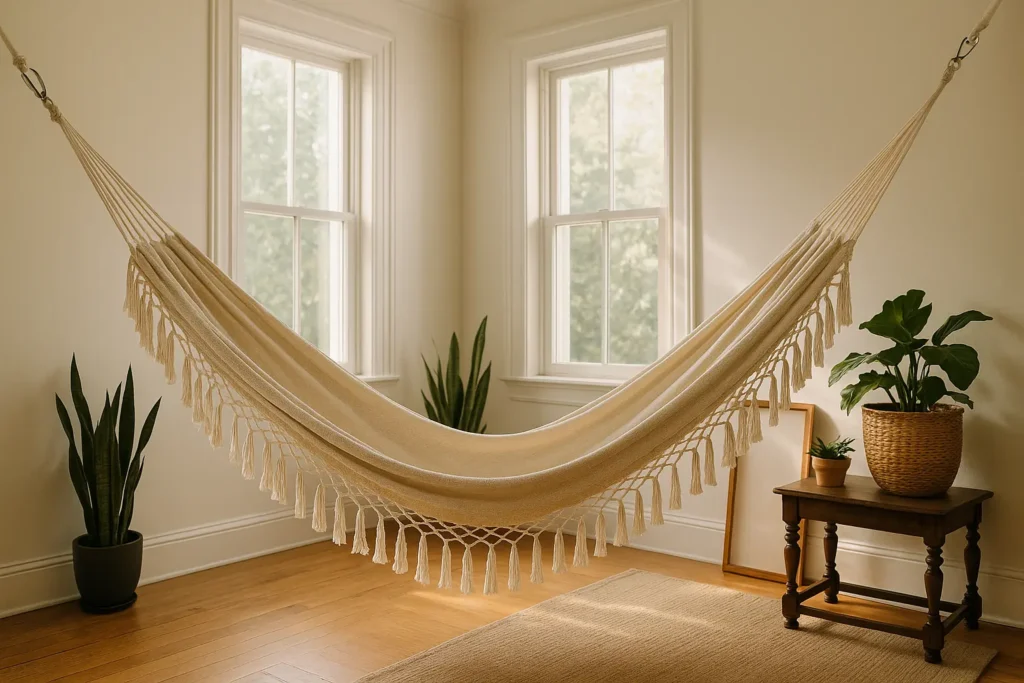
Optimal distances and heights
The golden rule for install a hammock at home : Both ends of your hammock should be fixed at the same height to ensure perfect balance. A hammock that's too tight significantly reduces comfort and puts more strain on the seams. Conversely, a nice curve allows for better weight distribution and invites you to sit diagonally, the ideal position to fully enjoy this suspended moment.
Installing a hammock indoors: practical solutions
Installerun hammock in a living room or bedroom opens up a world of possibilities. This installation offers you a relaxing space accessible all year round, perfect for reading or even an aerial yoga session. Each type of wall requires a specific approach.
| Wall type | Recommended attachment for install a hammock at home |
|---|---|
| Hollow red brick | Gym hook, chemical sealing |
| Hollow concrete block | Universal mounting kit (4 x 10 mm holes) |
| Solid concrete | Concrete anchor (1 15 mm hole) |
| Plaster tiles | 40×40 cm wooden plate at the corners |
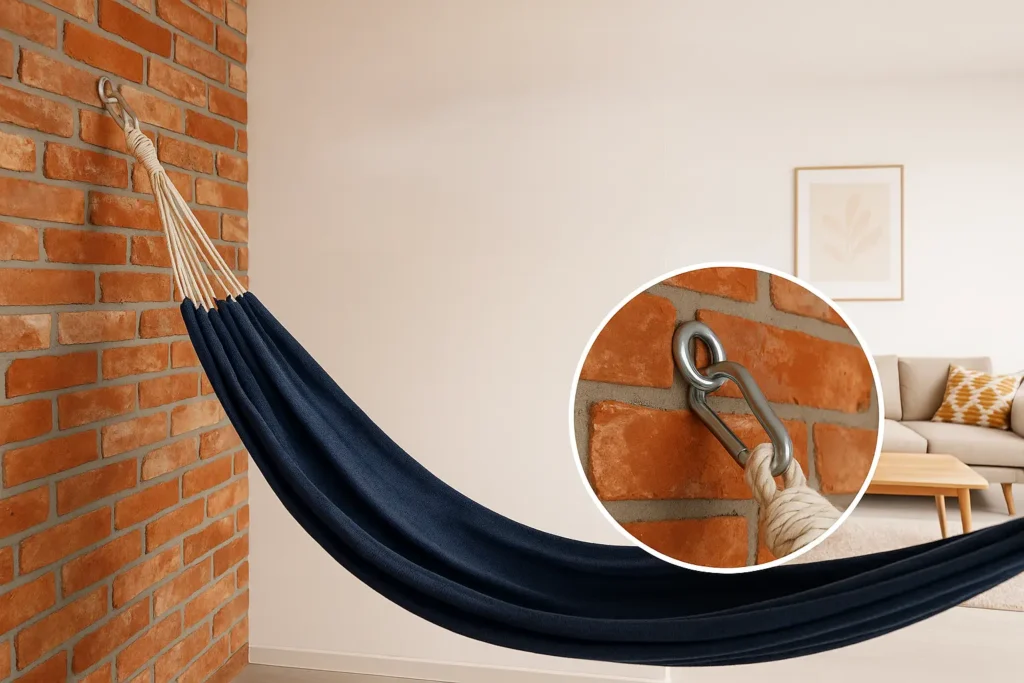
Wall fixings suitable for different materials
For a plasterboard wall, we recommend installing a vertical wooden beam (10x15 cm) running from floor to ceiling. This solution distributes the load and prevents damage to your partition. On exposed beams, wood screw eyebolts offer an elegant and discreet solution. For installation between two walls, choose an angled configuration rather than a face-to-face one for better force distribution.
Solutions for spaces without obvious anchor points
Even without solid walls or exposed beams, alternatives exist. Self-supporting brackets specially designed for Indoor hammocks offer complete flexibility placement. For concrete ceilings, special hooks allow for overhead suspension, ideal if you have generous ceiling height. This solution transforms any room into a suspended relaxation space.
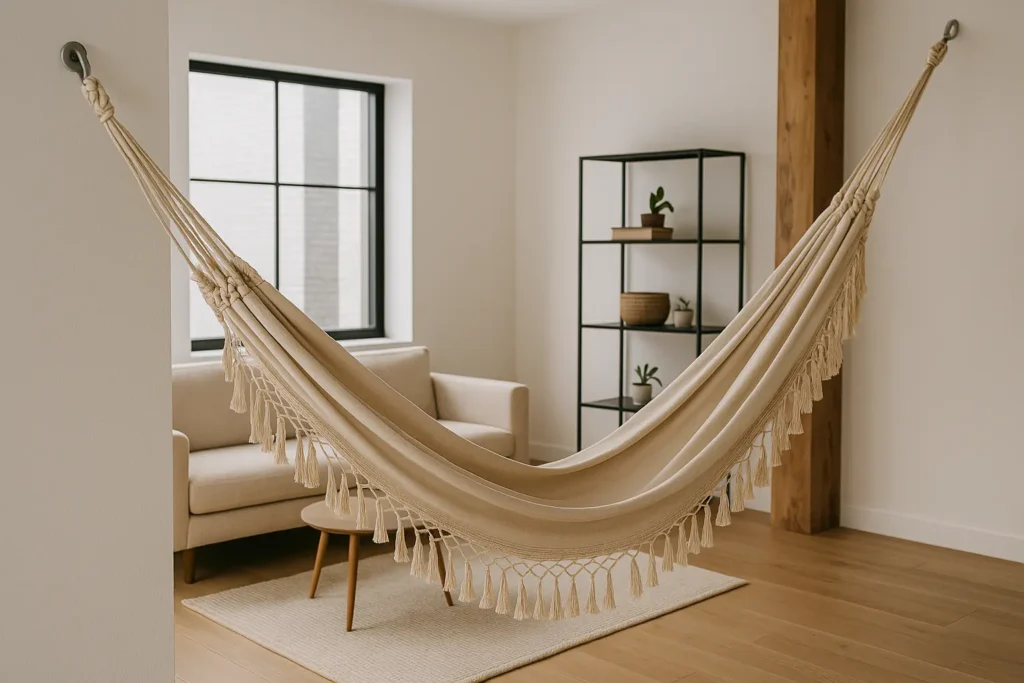
Installing a hammock outdoors: garden, terrace and balcony
Nothing beats the feeling of a hammock swaying gently in the outside breezeWhether you have a large garden or a modest balcony, there are several configurations available to you to create your outdoor relaxation area.
Between the trees: respectful installation
Trees are the perfect natural support for your garden hammock. Choose mature specimens with strong trunks and avoid young shoots that could bend under the strain. Always protect the bark with wide straps or an intermediate protection between the rope and the trunk. Unlike the trumpet vine, which has many disadvantages in the garden, a hammock well installed between two trees does not pose any problem for cohabitation.
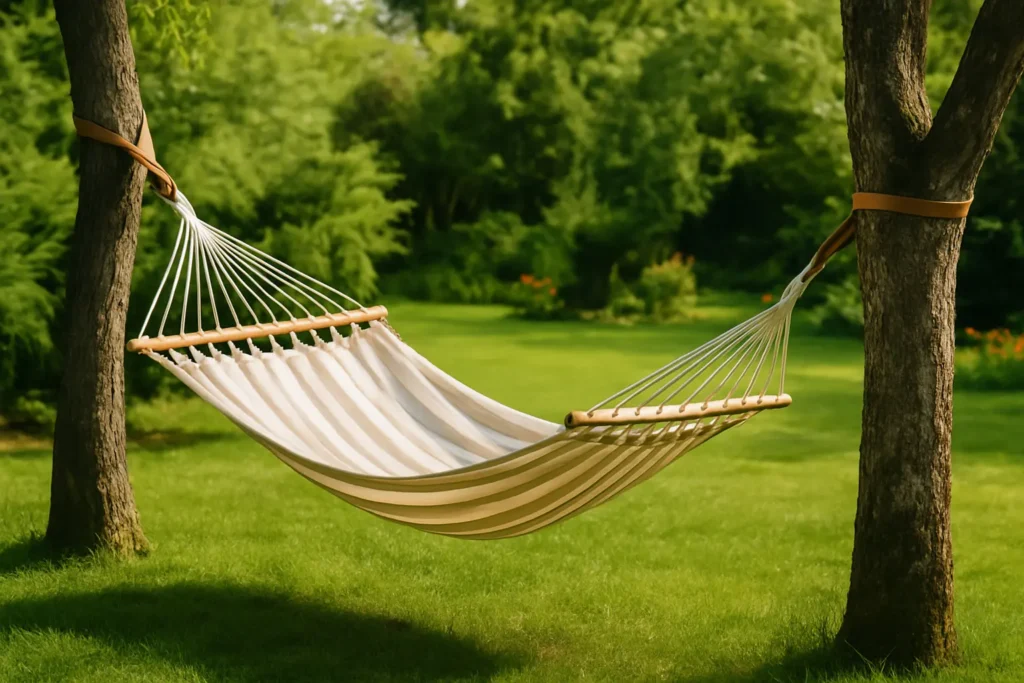
Create artificial anchor points outdoors
Without trees, other solutions exist. On sandy soil, dig a hole 80 cm deep to plant a post, secured with two slabs of treated wood. For earth soil, fill the same hole with concrete and wait three full days for it to dry. On a balcony or terrace, check the strength of the railings before attaching one side of your hammock, while the other end can be anchored to the wall of the house.
Master the essential fastening systems and knots
Choosing the right fasteners and mastering a few basic knots will ensure the safety and longevity of your installation. Suspension systems vary depending on location and use what you plan to do with your hammock.
Comparison of different fixing systems
For permanent installation, choose universal mounting kits or gym hooks. Straps offer more flexibility than traditional ropes and are more gentle on tree bark. Carabiners make setting up and taking down your hammock much easier, perfect if you want to store it in the winter or take it on a trip.
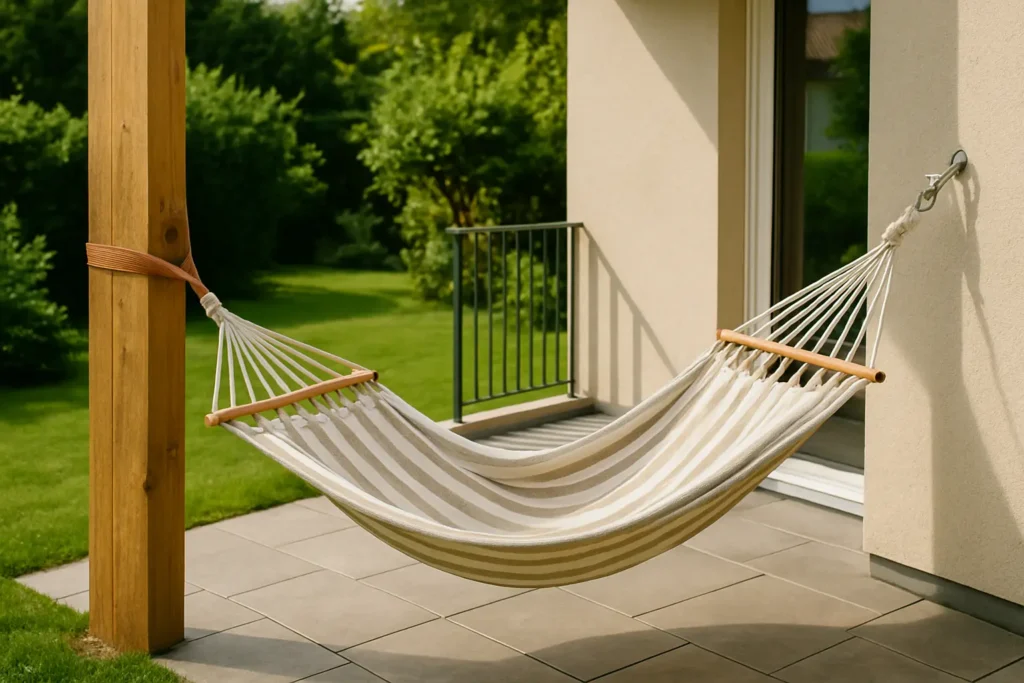
Knotting Techniques for a Secure Installation
A few simple but effective knots will suffice for most installations:
- The loop knot: fold the rope in two, go around the support, then pass the ends through the loop formed
- The bowline knot: ideal for creating a loop that won't slip
- The Hangman's Knot: Perfect for Height Adjustments
- The fisherman's knot: to securely connect two ropes together
Optimize the comfort and safety of your hammock
An improperly adjusted hammock can turn a relaxing moment into discomfort. For an optimal experience, a few adjustments and checks are necessary.
Adjustments for optimal comfort
To sleep comfortably in your hammock, position yourself diagonally (30° angle to the center line). This traditional position significantly improves comfort and avoid the feeling of being compressed. For long naps, a pillow under your knees or head provides welcome extra support. If you want to turn your garden into a true oasis, avoid planting a fig tree with invasive roots too close to your hammock area.
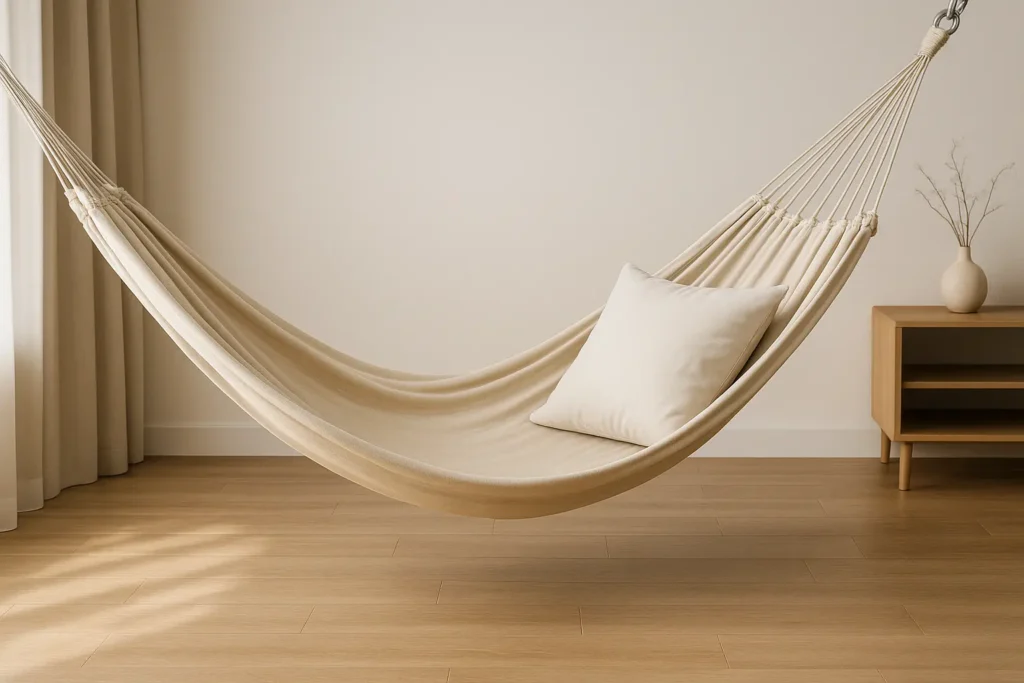
Regular maintenance and safety checks
The safety of your hammock depends on regular maintenance. Check the condition of the fasteners and the wear of the ropes or straps before each extended use. For outdoor hammocks, a polypropylene model will withstand the elements better than a cotton hammock, which will need to be brought inside or protected in case of rain. Remember to respect the maximum load indicated by the manufacturer – generally between 120 and 200 kg depending on the model.
Hanging a hammock at home invites travel and relaxation into our daily lives.Whether you choose an indoor installation for meditative breaks or an outdoor arrangement to enjoy the sunny days, this suspended cocoon will offer you precious moments of disconnection. So, are you ready to rise above the daily grind?
